 |
|
|
Introduction:
The Lightning Strike system is a package sold by Brite-Strke for personal defense, and their target market for this is females. But, you might ask, why do you want a flashlight for personal defense? The short answer is, more than you might think – consider that the majority of attacks occur at night, or at least in the dark, a good flashlight, used properly, can buy you precious moments to escape or fight back. According to Steve Tarani, a respected self-defense instructor and author, “You’d better have something else up your sleeve to back it up after he squints, turns his head and re-focuses his attack.” Still, a good light is a great place to start, and useful to boot. With that in mind, I’m going to consider it as a self-defense tool, and as a general purpose pocket light for EDC (every-day carry – read as, not something you leave at home).
Stop AOW:
The main purpose of this light it not to be a tac-light in the traditional sense. Rather, it is designed with the intent to stop an attacker without having to use force. Where a traditional tac-light would be a reactive tool to enable or enhance the use of force given by a law enforcement official, the Lightning strike is designed to be proactive, empowering the civilian to stop the assault before it ever occurs. Bright strike has done many things inthe past to help stop assaults on women, and this is the most recent. Brite-Strike has also announced their First Annual Rally for the Stop Assaults On Women foundation, held on April 26, 2009 in Kingston, Massachusetts.
Packaging:
Brite Strike packages the Lightning Strike system in a fairly classy embossed gift box that would be appreciated by any girl heading off to college. Everything is tucked inside a velvet-covered foam cutout, which holds the items in place and serves to protect them during shipping. The package also includes a few carry options for the light, and a small high-dB panic alarm, though this is not much to write home about. Similar things have been on the market for a while now; this only differs in its size and convenience.
|
The Lightning Strike comes in a plain white box…
|
… concealing a very nice presentation box.
|
|
Inside, we find everything nicely packed in velvet-lined foam…
|
Inside the box, we find the holster, the light (with SD card and quarter for scale), one AA battery, the alarm, and a springy lanyard.
|
 |
A Closer Look:
Back to the flashlight, this bad boy is made from CNC-machined aluminum, with a mil-spec HA-3 hard-anodized coating. This offers a very good strength/weight ratio, and the coating makes them remarkably resistant to scratches and corrosion… though strong bases (like that found in drain cleaner and alkaline batteries) will eat through the coating and eath away at the metal. Making our way back, there’s a series of aggressive grooves cut into the metal, making keeping your grip on the Lightning Strike, even when your hands are covered in oil, remarkably easy. Wrapped around the tailcap is a matte black, spring-steel clip that may not be thick enough to clip it all the way to thick pockets, or considering the target market, leather purses. Climbing all the way to the end, the tailcap is crowned with a glow-in-the-dark push button, and the unique ‘Tactical Touch’ switch. While the push button is a fairly common “reverse clicky” switch, it is the most tightly tuned example I’ve ever seen, requiring the least pressure to switch modes of any like it I’ve tried. Modes are changed by clicking or double-clicking the switch a quarter-press, moving from high, to low, to the blinding tactical strobe (looping back to high again). What makes this interesting is also the cut-outs on the switch, which are designed to protect the switching mechanism if dropped, and allow the smack to be laid down (remember, this is designed to be used as a fist-load). While ostensibly, they intended this cutout to accommodate women with over sized fingernails, I’ve found it to be a good idea in more than just that situation – it also allows the light to tailstand (it’s a bit wobbly, though), acting as an area-light with light reflected by the ceiling.
Speaking of batteries, this is somewhat unique in tactical lights, in that it uses AA batteries. Alkalines have some trouble supplying the currents demanded by powerful LEDs (when I first picked this up and turned it on, I thought it was broken – but it was just a dead battery), though rechargeable ni-mh cells tend to do much better under load (and eventually pay for themselves with the money you save). That said, Brite-Strike recommends against rechargeable batteries, as they have a bad habit of running themselves down even if you don’t use them. I tried Energizer lithium cells, and they were just as bright as the rechargeables, lighter, and they never leak.
The batteries are feeding a Luxeon Rebel emitter by Phillips LumiLEDs, who developed the first high-power white LED, the Luxeon Star. I’m not sure of the exact bin code (model number) of the emitter, but the light is (by LED standards) a warm, peachy white; not the usual harsh, cold blue-tinted light produced by LEDs. That is to say, this is a premium LED, which often perform better outdoors, where plants and trees gobble up the blue end of the spectrum. While the ‘Luxeon lottery’ means all such things may vary, this is a good sign.
–~~~~~~~~~~~~–
 |
Testing:
The LED is supposedly pumping out 65 lumens of luxurious warm light on high, which coincidentally is the same as the venerable Surefire 6p. It’s also about as much as a 3-D Maglite, but a bit over a tenth the size. Now, 65 lumens may not sound like a lot if you know a thing or two about flashlights, but it’s been enough for police lights since 1986. Also, it was very nearly as bright as my Ra Twisty, one of my other lights that is known for exceptionally accurate calibration, actually more so even than any of my photographic equipment. It’s also rated at 85, so there may be a bit of under-rating going on by Brite Strike, but it may be the rechargeable batteries I tested with. Still, this is 2009, not 1986, and the cutting edge for LED lights on one AA is now 130 lumens (though not only runtime is a bit shorter than the Lightning Strike’s, it tends to choke on alkaline batteries you can buy at Wal-Mart). On the other hand, engineering reality dictates: “small, bright, long-running – pick two”; it seems that Brite Strike, given the targeted audience, has opted for improved runtime and better compatibility with alkaline batteries here.
| Features | What It Means |
| Small enough to hold comfortably in one hand for use as a defensive weapon in case of attack. | The perfect size for a fist-load, with the thumb on the switch and the pointy end protruding from the butt of the fist. Perfectly sized for people with small hands. |
| Unique “Tactical Touch ™” end cap switch allows the user to switch from high to low to blinding strobe settings, all with a light touch of your finger. | Reverse-clicky switches are not unique, but this is a great example of the type. Guarded tailswitch unlikely to come on accidentally, still maintaining reasonable ease-of-access. |
| The flashlight comes with a leather quick deployment fashion holster with a “writsty” so the light can be carried on your wrist, or be clipped on the outside of a purse, briefcase or clothing. | “Wristy” = wrist strap. Bad marketing, good holster. Gloss black leather. “Wristy” can’t be attached to the light, only the holster. |
| The personal safety alarm is small and rugged, yet loud enough to scare off an attacker and alert others. | Great to clip to your keys, but I’d rather have a small semiautomatic handgun. |
Considerations:
Another word on brightness – having tried both alkaline batteries, and Energizer L91 AA lithiums, and Sanyo Eneloops (high-quality, low-self-discharge rechargeable batteries) the L91 and Eneloop seemed to buy me another 20 lumens or so, tested with the less-than-scientific ceiling-bounce method. Both hold up their output voltage better under high current draw, resulting in more power being delivered to the important components. In my experience, the Eneloops offer high capacity, high currents, and none* of the runs-down-in-storage effect that plagued previous generations of the technology. For something to be carried in case of trouble, I strongly recommend either Eneloops or Energizer AA lithium batteries be used in this light, to get the best performance. (*Technically, the Eneloop will be at 80% capacity after two years of storage. You’ll run it down rather before then and recharge it.)
On the topic of self-defense, I will admit that I am not an expert. However, in fending off someone who is seriously willing to do you harm, I’d recommend you bring one of these, a black belt in krav maga, a retractable baton, and a small-frame concealed handgun. This may or may not be practical for you, but the better prepared you are, the better.
Be that as it may, we put the Lightning Strike up to the same test that we did with the Blue-Dot Tactical Series, also made by Brite Strike. Although this light is not on the same level, the testing can be compared with a hope of achieving similar results. We offered a friend ten bucks to walk over and slap me. He laughed and said okay. We dimmed the lights so you could just see what you were doing, similar to lighting conditions you would find in a dark parking lot. He laughed…walked over and got a taste of lightning. Well, not literally, but he was pretty well blinded for a second there, and we were able to sneak around him without him noticing. While this test seems silly, it serves as an example of the power that a simple light can have in the time that you need it most
The tactics recommended by Brite-Strike involve a fighting retreat, which is all well and good. While you might find the rest of my ideas on the topic impractical (or illegal, depending on your jurisdiction… but concealed carry is getting more broadly legal by the day), I think that anyone interested in this sort of thing should probably be taking a martial-arts class. If it’s nothing else, it’s good exercise and piece of mind.
 |
Tech Geekery, and Fiddly Little Concerns:
- O-rings and threads came bone dry. I may be wrong and there was a very fine lube, but it seems to be shedding aluminum powder after a few on-off cycles and turns rather roughly.
- Threads were an unusual combination of conventional, saw-tooth shape (sloped edges) and the unusual square threads (flat tops) found on the Surefire Aviator. Machining on them was a bit course, but they ensured there was no threat of cross-threading.
- Clip held tight, but was a little hard to put on a pocket. Thicker pockets might play badly with this clip.
- The tailcap guards are drilled for a lanyard, but the holes are just a bit over 1mm – a bit thin for paracord.
- The window is reportedly high-quality uncoated polycarbonate.
- The reflector has an unusual, light texture which is not so smoothly textured as most, and consists of flat plateaus on the ‘flat’ surface of the parabola.
- There was an intermittent problem with the circuit, which lead to flickering and a diagnosis of a dead battery – but only once. Manipulating the tailcap fixed it, but it came back. The second time, it was much more flickery and less not-turning-on.
- Threads became much smoother with a generous dab of Magic Lube, a silicone/teflon grease used to seal O-rings on swimming pools (what I keep on hand). This also may have fixed the flickering issue.
- Mechanical reverse-polarity protection; the positive contact in the head is reversed inside a shallow divot just big enough for the + terminal on a AA battery.
I got to playing with the multimeter a bit, and took some voltage and current measurements in place of the tail cap. The battery measured 1.256 volts, and I’ll assume it’s constant when the light is switched on. Set to high, it pulled 0.45 amps; on low, it drew 0.14 amps. Multiply these, and the result is 0.56 watts on high, and 0.17. At 65/20 lumens, this gives 115 and 113 lumens per watt, respectively. I know for a fact that the highest bin being sold is the M bin, producing 90 to 100 lumens per watt, so there seems to be something slightly fishy going on here. First I must check my assumptions: I am assuming that the rated brightness is correct, I am assuming my meter is accurate, and I am assuming the battery is not dropping voltage under load. The most unlikely of these is that the battery is not dropping – though if they were, the regulator circuit would pull more current to compensate, dropping the calculated lumens/watt. This means that this is not the effect seen here. More data can be gathered by using an Energizer lithium AA, another battery that yields a very constant voltage under load. The example I had was partially depleted, clocking in at 1.562 volts; on high, the circuit drew .53 amps, and .19 amps on low (translating into .83 and .30 watts, respectively). Why is this important? At higher voltage, the circuit drew higher current. This gives us 78 and 67 lumens per watt for the entire flashlight’s emitter and electronics at rated brightness. These numbers are quite realistic, suggesting I made a mistake assuming the light operates at full brightness on rechargeable batteries. While the documentation included states that the Lightning Strike is compatible with “quality AA size Alkaline or Ni-MH batteries and with min capacity 1600mAh”, the use of conventional rechargeable is also not recommended. (The use of rechargeable alkaline cells, a type of battery no longer widely sold, is according to the manual capable of damaging the light over time, probably by over-driving and frying the LED.) Take home message of this paragraph? Lithium AAs are the best battery for this light, followed by good nickel metal hydride rechargeable (I use and recommend Sanyo Eneloops) followed finally by normal AA alkaline cells (which the manufacturer recommends replacing every two months regardless of the lack of any actual use).
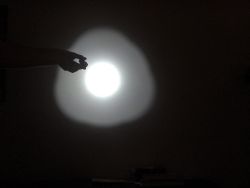 |
|
| Lightning Strike beam profile at 1/2 meter |
–~~~~~~~~~~~~–
 |
Conclusion:
Now, the proof of the pudding is in the eating, so I did what any idiot does when you hand them a battery-powered sunbeam and blasted myself in the face… with the strobe. First, of course, the lights were turned off in order to get the effect you’d find using it on someone who jumped out of a dark alley somewhere. Yeowch. I left myself blind for a good five seconds and seeing stars for rather longer; I have no doubt that in full dark you’re likely to have the intended blinding effect. I also tried it around the house as just a flashlight; it proved more than up to the task of running cable behind furniture, checking the mail in the dark and rain (conveniently proving the light weatherproof as well), and other household tasks. What it was meant as is a pocket-sized flashlight to use in defense of life and limb, and it succeeds pretty well. It basically blows away almost everything in its size class. Still, at $50 it’s a bit steep for many people; others such as JetBeam and NiteCore offer similar products at a slightly higher price and not even a notch above as far as quality. If you just want something to make things light up, this probably isn’t the best choice. But if you’re going for something black, scary, and handheld (and a blinding tactical strobe) that feeds from a single standard AA, there really is little to no competition for the Lightning Strike. The only possible competition in this role is the NiteCore Defender Infinity, which is considerably more complicated to run. As this is as simple as learning to double-click with your thumb, you’re trading a bit of output for usability. Despite this, Brite-Strike’sLightning Strike is still a strong contender, but not quite the dead ringer it could have been.
Awesome:
- Glow-in-the-dark button
- User interface easy to explain and easier to use
- Aggressive grooving makes for solid grip
- Neutral/warm Rebel makes color easy to see, well-focused hot spot
- Reverse-polarity protection means a backwards battery can’t fry the light
Lame:
- Alkaline batteries not very powerful, can leak, and dimmer than lithium
- Lithium batteries expensive, only one manufacturer (Energizer)
- Strobe is awkward to deploy in a pinch, requires triple-clicking
- No anti-roll features but the removable clip
- Developed an intermittent flicker during testing, requiring the greasing of the tail cap threads and O-ring.
Verdict:All the non-techies I showed this to thought it was a really nice light – and most of the techies, too. At $50, it’s a pretty good deal; it’s easier to use and cheaper than its competition.
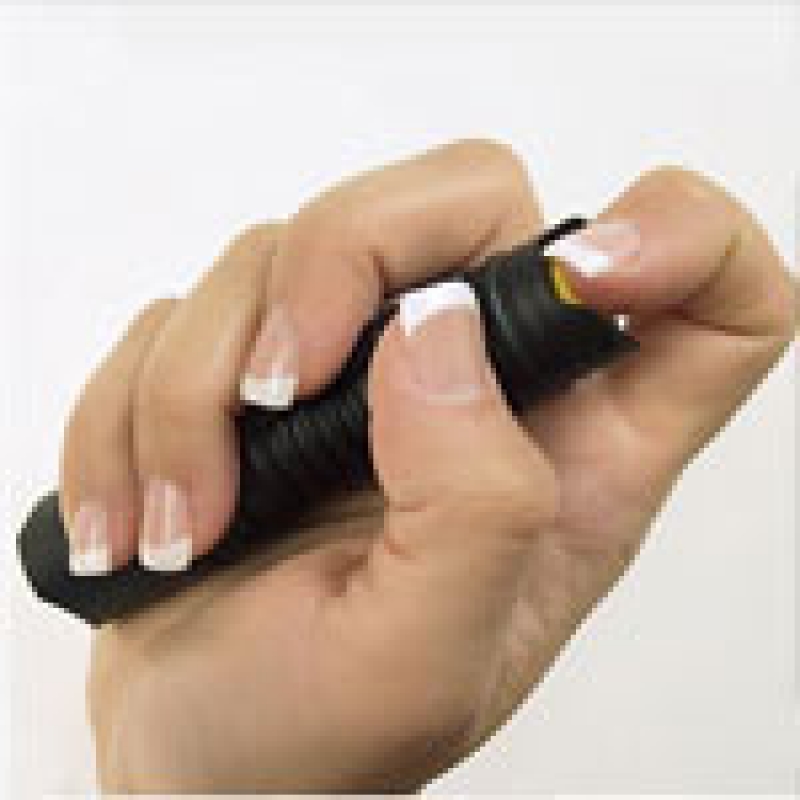
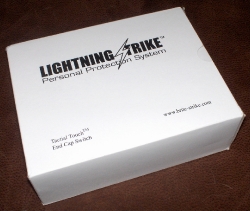
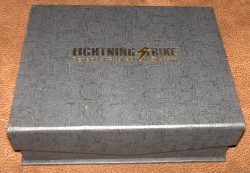
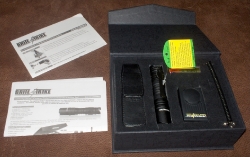
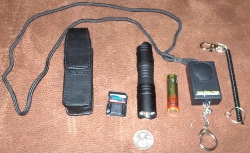
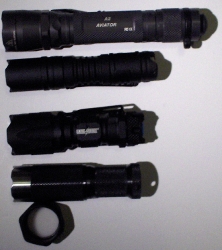
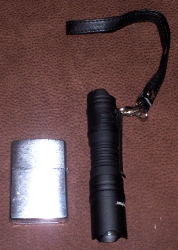
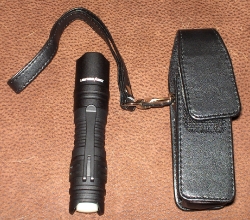

[…] Brite-Strike Lightning Strike Tactical Flashlight Review @ Techwarelabs […]
[…] Brite-Strike Lightning Strike Tactical Flashlight Review @ Techwarelabs […]